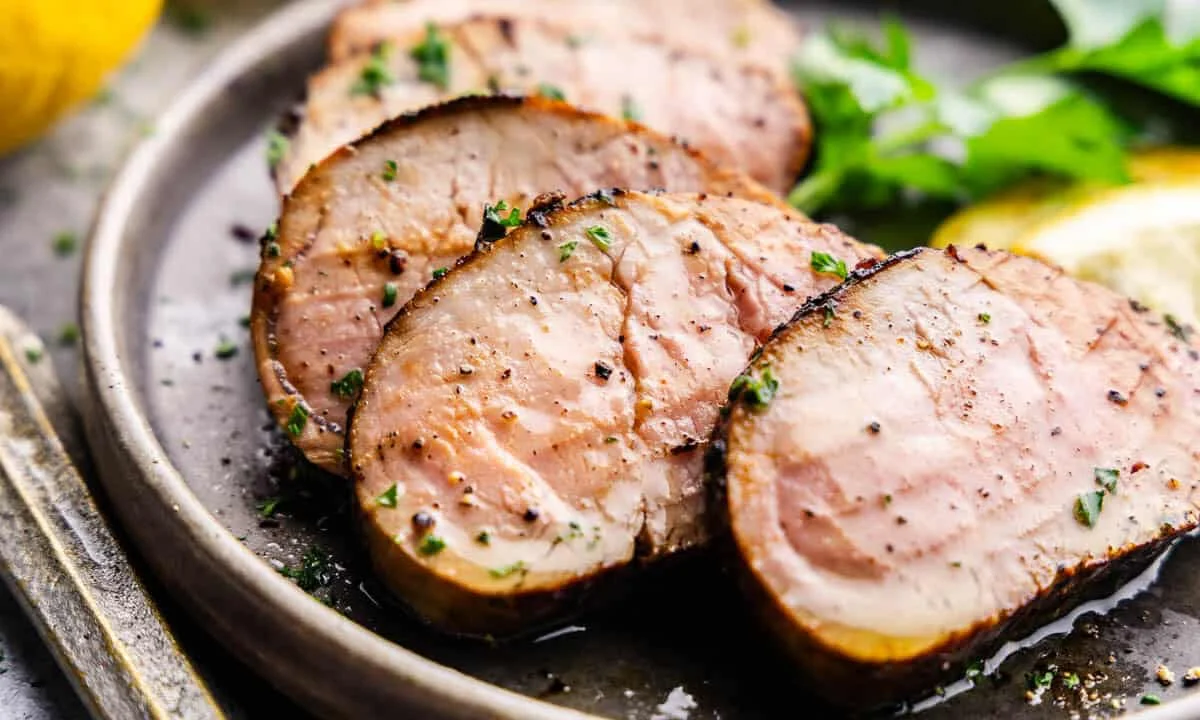People commonly refer to pork as “the other white meat” because it offers lean protein like poultry. It provides many of the same nutrients as beef, but with less fat and calories, depending on cut and cooking. People widely consume pork globally, especially in the United States and Asia, though many religions, like Islam and Judaism, prohibit it.
Table of Contents
TogglePork Nutritional Statistics
The USDA provides the following nutritional information for a 3-ounce (85-gram) portion of roasted tenderloin.
- Fat: 3g
- Sodium: 48mg
- Carbohydrates: 0g
- Calories: 122
- Sugars: 0g
- Fiber: 0g
- Niacin: 6.3mg
- Protein: 22g
- Phosphorus: 227mg
Carbohydrates
Pork is carb-free unless it is prepared with breading, barbecue sauce, or other sugars or starches.
Fats
It contains both saturated and unsaturated fats. Choose pork loin or tenderloin for lower fat content.
Protein
Indeed, pork can serve as an excellent source of lean protein, contingent upon the specific cut chosen.
Minerals and Vitamins
It excels as an excellent source of thiamin, niacin, riboflavin, vitamin B6, and phosphorus, while also providing a good supply of zinc and potassium.
Calories
Primarily, a 3-ounce serving of tenderloin derives its 122 calories from protein, with fat contributing a secondary caloric source.
Diverse cuts of meat exhibit distinct nutritional profiles. To illustrate, let’s examine the nutritional composition of a couple of popular pork products.
- Lean pork cutlet/steak: 239 calories, 34g protein, 10g fat, 4g saturated fat, 697 mg sodium, 0g carbs.
- Three ounces of cooked ground pork: 252 calories, 22g protein, 18g fat, 7g saturated fat, 62 mg sodium, 0g carbs.
- Three ounces of pork chop have 180 calories, 24g protein, 9g fat, 2g saturated fat, 438 mg sodium, and 0g carbohydrate.

Health Advantages
It is a nutritional powerhouse, boasting a comparable micronutrient profile to beef, including a substantial amount of protein. However, pork fat content can be lower than beef, depending on the cut and preparation.
Ensures Muscle Mass
As we age, our muscles undergo a natural decline, predisposing us to frailty and injury. However, a strategic approach involving adequate dietary protein consumption and consistent physical activity can effectively mitigate this age-related muscle loss, commonly referred to as sarcopenia.
Improves Cell Growth and Function
Pork, akin to other animal-based proteins, is a rich source of B vitamins, notably thiamine, niacin, riboflavin, and pyridoxine (B6). B vitamins transform food into energy, help the brain operate, repair DNA, and generate hormones and red blood cells.
Sensitivity
Meat from any mammal, including pig, may cause an allergic reaction. Interestingly, scientists have linked certain allergies to unexpected culprits, such as Lone Star tick bites and even cat allergies.
Meat allergies typically develop in adolescence or age. If you suspect a pork allergy, consult your doctor about your diet and any treatments you may require.
Negative Effects
Processing or cooking pork with salt can significantly elevate its sodium content. Consequently, individuals seeking to reduce sodium intake may need to exercise caution when selecting specific pig preparations.
Furthermore, eating a lot of well-done meat, notably pig, can raise cancer risk. Well-done cooking processes generate heterocyclic amines within meat, substances linked to an increased risk of various cancers.
Consuming raw or undercooked pig is also harmful. Pork can harbor parasites that cause serious human illnesses. However, thoroughly cooking the meat effectively eliminates these parasites.
Food Safety and Storage
Sealed fresh pig chops maintain optimal freshness for a duration of two to four days when refrigerated. Ground pork maintains freshness for a shorter duration, typically one to two days. It can also be sealed tightly with freezer wrap and frozen. Use the frozen pork within six months.
Frozen pork should be thawed in the refrigerator, not at room temperature. A small roast will thaw in 3 to 5 hours per pound, whereas a 1-inch thick cut will take 12 to 14 hours.
Cook pork to an internal temperature between 145°F and 160°F, measuring the thickest part of the flesh without touching bones.
How To Get Ready
For a diverse and nutritious diet, consider incorporating pork as a lean protein alternative to chicken or fish. Versatile and flavorful, pig can be effortlessly integrated into tacos, salads, soups, and stir-fries. Moreover, dietary diversity enhances meal satisfaction and ensures optimal nutrient intake.




